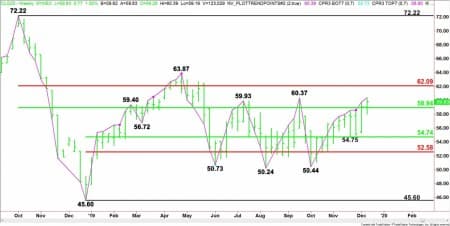U.S. West Texas Intermediate crude oil futures are barely holding on to their marginal weekly gains early Friday as confusion has set in over whether there is a trade deal between the United States and China.
Earlier in the session on Friday, the market hit a three month high in response to the news that the United States and China had reached a “phase one” trade agreement.
Three sources close to the talks told CNBC on Thursday, the Trump administration has reached a phase one trade deal with China in principle, pending approval from President Donald Trump.
Crude oil prices retreated from its weekly high as investors digested mixed news around U.S.-China trade relations after President Trump tweeted a Wall Street Journal report on the U.S.-China trade deal is “completely wrong.”
That appears to the story driving the price behavior at the end of the week, and it could determine whether the market closes higher or lower for the week. Depending on the circumstances, this event could influence the longer-term direction of the market.
China Press Conference Could Be Key Influence on Prices
China has scheduled a press conference for early Friday (stateside) that could also dictate this week’s close and next week’s direction. Basically, “trade deal on” is likely to underpin prices, and “trade deal off” is likely to encourage profit-taking and position-squaring.
Conventional Supply/Demand Analysis
API, EIA Report Weekly Inventory Builds
On…
U.S. West Texas Intermediate crude oil futures are barely holding on to their marginal weekly gains early Friday as confusion has set in over whether there is a trade deal between the United States and China.
Earlier in the session on Friday, the market hit a three month high in response to the news that the United States and China had reached a “phase one” trade agreement.
Three sources close to the talks told CNBC on Thursday, the Trump administration has reached a phase one trade deal with China in principle, pending approval from President Donald Trump.
Crude oil prices retreated from its weekly high as investors digested mixed news around U.S.-China trade relations after President Trump tweeted a Wall Street Journal report on the U.S.-China trade deal is “completely wrong.”
That appears to the story driving the price behavior at the end of the week, and it could determine whether the market closes higher or lower for the week. Depending on the circumstances, this event could influence the longer-term direction of the market.
China Press Conference Could Be Key Influence on Prices
China has scheduled a press conference for early Friday (stateside) that could also dictate this week’s close and next week’s direction. Basically, “trade deal on” is likely to underpin prices, and “trade deal off” is likely to encourage profit-taking and position-squaring.
Conventional Supply/Demand Analysis
API, EIA Report Weekly Inventory Builds
On the supply side, both the American Petroleum Institute and Energy Information Administration weekly inventories reports showed unexpected builds in crude oil supply.
The American Petroleum Institute (API) reported an estimated weekly crude oil inventory build of 1.41 million barrels for the week-ending December 4. Analysts were looking for a 2.763-million-barrel draw in inventory.
The U.S. Energy Information Administration (EIA) reported a crude oil inventory build of 800,000 barrels for the week-ending December 6. Traders were expecting a 2.9-million-barrel draw in inventory. The EIA also reported a gasoline inventory increase of 5.4 million barrels.
OPEC, IEA at Odds over Demand Growth
The demand side of the equation proved to be a little confusing for traders after a forecast from OPEC called for a supply deficit next year while the International Energy Agency (EIA) predicted slower demand growth.
OPEC on Wednesday said it now expected a small deficit in the oil market in the next year, suggesting the market is tighter than previously thought – even before the latest pact with other producers to curb supply takes effect.
The revised forecast by OPEC marks a further retreat from a prediction of a glut in 2020 as U.S. production growth begins to slow.
“Despite the additional curbs…and a reduction in our forecast of 2020 non-OPEC supply growth to 2.1 million barrels per day (bpd), global oil inventories could build by 700,000 bpd in Q1 2020,” the Paris-based IEA said in a monthly report.
Even if the group adhered strictly to the new pact and output from members beset by political troubles like Iran and Venezuela stayed steady, the IEA said only 530,000 bpd of crude would be withdrawn from the market compared to November production.
OPEC, led by de facto Saudi Arabia, and other producers including Russia agreed last week to rein in output by an extra 500,000 bpd in the first quarter of 2020 in order to balance the market and buoy prices, but stopped short of pledging action beyond March.
Technical Analysis
Weekly February WTI Crude Oil Technical Analysis

Trend Analysis
The main trend is up according to the weekly swing chart. The uptrend was reaffirmed on Friday when buyers took out the previous main top at $60.37.
The main trend will change to down on a trade through $50.44. This is unlikely over the near-term. However, the prolonged move up in terms of price and time has put the market in a position to post a potentially bearish closing price reversal top.
A weekly close under $59.10 will form this chart pattern. It won’t mean the trend is changing to down, but it will indicate the selling is greater than the buying at current price levels. This could lead to a 2 to 3 week normal correction.
The main range is $72.22 to $45.60. Its retracement zone at $58.94 to $62.09 is potential resistance. It is also controlling the longer-term direction of the crude oil market.
The short-term range is $45.60 to $63.87. Its retracement zone at $54.74 to $52.58 is the best support area.
Trend Forecast
Based on this week’s price action, the direction of the February WTI crude oil market this week will be determined by trader reaction to the main 50% level at $58.94.
Bullish Scenario
A sustained move over $58.94 will indicate the presence of buyers. If this move creates enough upside momentum then look for a test of $60.37. Taking out this top with conviction could extend the rally into the main 61.8% level at $62.09. Overcoming this level will indicate the buying is getting stronger with the main top at $63.87 the next target.
Bearish Scenario
A sustained move under $58.94 will indicate the return of sellers. This could trigger a break into minor support at $57.57. Since the main trend is up, buyers are likely to come in on a test of this level. If it fails then weakness could extend over the near-term into $54.74.
Conclusion
We’re still in a news-driven market so expect heightened volatility until the confusion over the U.S.-China trade deal is cleared up.


















